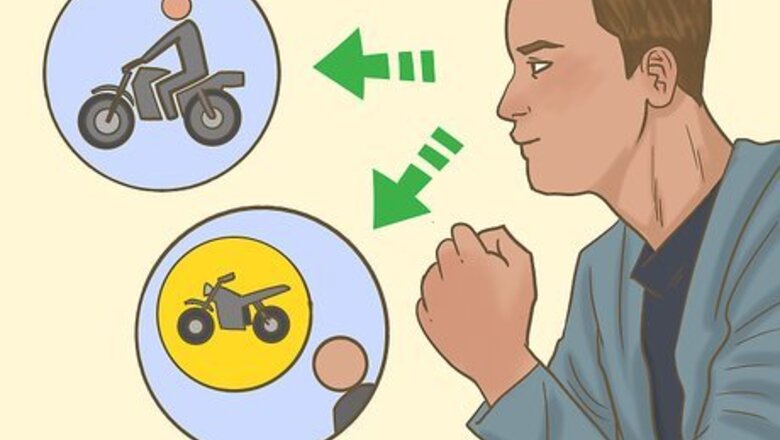
views
Forming the Club
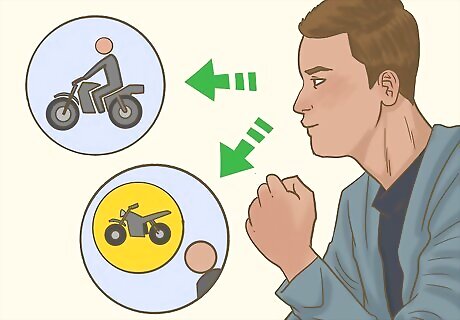
Decide on a general theme or purpose for your club. Be clear about your reasons for wanting to start a motorcycle club in the first place. Does it begin and end with your love of bikes, or does it have more to do with your longing for friendship and freedom? What’s the main thing you hope to accomplish? Asking questions like these will help you begin forming a vision that you can use to guide the creation of your club. Generally speaking, motorcycle clubs fall under one of two main categories: riding clubs, which are mostly concerned with riding, working on, and discussing motorcycles, and “MCs,” which also embrace the more tribe-like aspects of cycle culture. If you’re mostly interested in riding, you won’t need to worry too much about building an image or establishing a hierarchy for your club. If you’re leaning more towards the MC course, you’ll want to keep these sorts considerations in mind going forward.

Think about whether you’ll accept all bikes or just a specific brand. Some clubs are adamant that their members all ride the same brand or style of bike—the H.O.G. (short for Harley Owners Group), for example, all ride Harley Davidson motorcycles. However, there’s no rule that says this has to be the case. You have the freedom to accept anyone regardless of what they have between their legs. Ultimately, it comes down to your own preferences. Opening your club to all bike owners will allow you to share the simple joy of riding with more people. If you’re passionate about a particular brand of bikes, it might make more sense to restrict your membership to owners who are as loyal to that brand as you are.
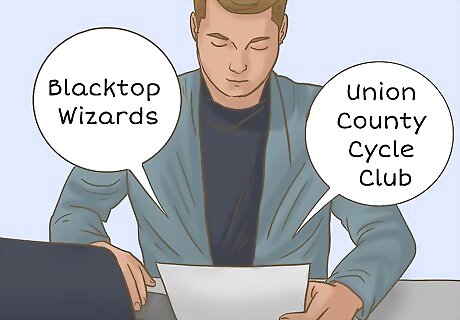
Come up with a fitting name that represents your club. Now that you’ve outlined your reasons for starting your club, put some thought into what you want to call it. Choose a name that exemplifies some part of your philosophy, image, or purpose. A name like “Blacktop Wizards,” for instance, suggests impressive riding ability and a sense of style, while something like “Union County Cycle Club” will give non-members a more straightforward idea of who you are and what you do. Most MCs include the name of their town, county, city, or territory to advertise their place of origin and distinguish themselves from other similarly-named groups. Avoid naming your club anything that sounds overly violent, intimidating, or offensive. Unsavory-sounding labels could give your club an undeserved bad reputation or even attract the attention of local law enforcement.
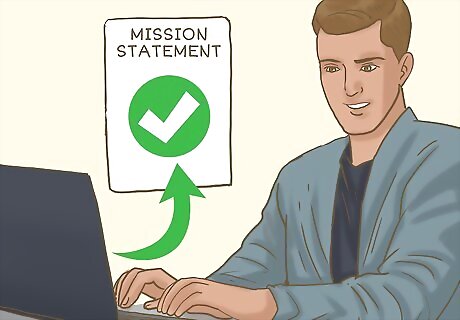
Draft a mission statement to help your club stand out. If you live near a major city, chances are there’s already at least one other MC operating in the area. Crafting a detailed mission statement will give you the opportunity to express your intentions for your club and explain what sets it apart from others. Try to convey a sense of the values and ideals that came to mind when you first had a notion to start your club. Your mission statement might start with a sentence like: “United Riders of Kalamazoo were founded with a single mission in mind: to heed the call of the open road and resurrect the ideals of freedom, adventure, and independence that make owning a cycle so thrilling in the first place.” Writing your mission statement can also help you further solidify your vision for your club.Tip: If you’re not sure where to start, try distilling your message down to one or two key words or phrases—recreation, brotherhood, community service, etc.

Create a logo and other visual elements to identify your club. Flex your creative muscle by sketching out an emblem (or “colors”) that symbolizes what your club stands for. If you have graphic design skills or know someone who does, take the time to piece together a high-quality rendering. Another option is to commission a professional artist to produce a logo for you based on an original idea. That way, you can make sure that the design has a polished, legitimate look. If your club is going to be known as “The Grotto Gearheads,” your logo might depict two bolt-shaped ‘G’s being tightened by a wrench, or something edgier, like a skull and two crossed pistons. Your club’s colors will be a visual representation of everything you do. You can use it to put your stamp on all materials produced by your club, including custom clothing and gear, newsletters, business cards, and social media profiles.
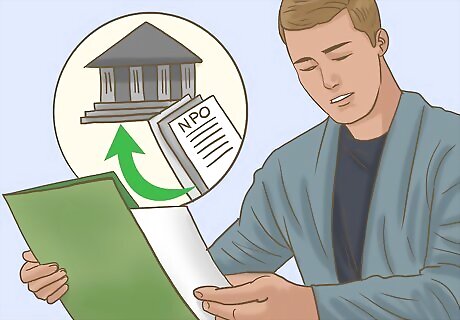
Consider registering your club as a non-profit organization in your state. Applying for recognition as a non-profit is often as easy as filling out a few pieces of paperwork, submitting a business plan or objective proposal, and providing the names of your main committee members. If your request is granted, your club will qualify for liability insurance, solicitation licenses, sales tax exemption and other legal benefits. A copy of your mission statement should meet the criteria for a business plan or proposal. In the United States, the Internal Revenue Service (IRS) is the governing body that oversees requests for non-profit status.
Recruiting Members

Make registration forms to hand out to prospective members. Have anyone who wants to join your club fill out a special application. This form should include all of the relevant information about the interested party, including their name, age, occupation, address, and the type of bike they own. A hopeful recruit’s registration form should tell you everything you need to know about them up front. Collect and review each application yourself to decide who to let in, or delegate the task to another trusted friend or club member. If you have any other requirements for joining, such as membership in a church or the absence of a criminal record, be sure to mention them in your registration forms as well.

Reserve first membership rights to your close friends and family. If you have loved ones who also ride and want to be a part of larger community, see if they would be interested in joining your club while it’s in its infancy. The members of motorcycle clubs often end up becoming as close as family, so it only makes sense to do your actual family and friends the honor of extending them the first invitations. Make sure you only ask loved ones who are legally eligible to own and operate a motorcycle in your home state or territory. The best part about bringing in friends and family is that you already know them well, which means you won’t have to worry about vetting them or pondering whether they’d be a good fit.

Put out an open invitation to other bike enthusiasts. To help get the word out, set up a Facebook, Twitter, or Instagram page where you can post club-related news and announcements. You could also try putting up flyers, posting on local message boards, or having your members spread the message to anyone else they can vouch for that might be willing to take part. Distribute flyers and similar materials in places where bikers are known to congregate, such as motorcycle retailers, racetracks, rest stops, and bars. A more inclusive club format will be your best bet if your goal is simply to meet as many fellow cycle aficionados as possible.
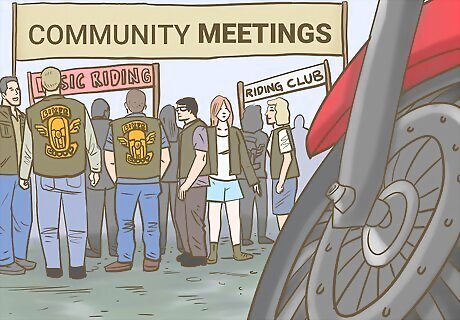
Organize community meetings to attract prospects around you. Start offering basic riding or maintenance lessons to the people who live in your area. These types of meetings will give you a chance to meet and interact with individuals in an intimate setting before you make up your mind whether or not to induct them into your club. They can also be a good way to gauge local interest in a formal club structure. Depending on the laws where you live, you may need a special permit to hold a gathering in a public place or provide instruction to unlicensed individuals.
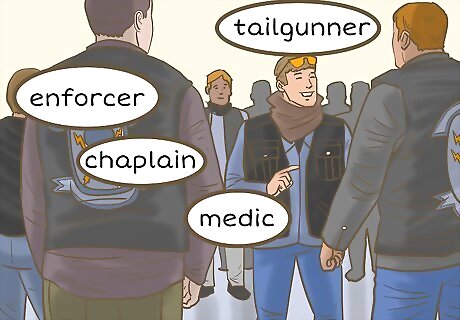
Appoint officials if you want your club to have a more official structure. Once you’ve begun adding members to your ranks, assign them various responsibilities based on their unique strengths and skill sets. If your club is big enough, consider holding interviews or elections to narrow down your candidates. A small local club may have a president (you), a vice president, and a road captain to lead group runs, while larger clubs who conduct internal business may also benefit from positions like secretary and treasurer. Some other officials you might choose to have in your club include enforcer (a member tasked with ensuring that other members follow club bylaws), chaplain, medic, and “tailgunner,” or emergency repair specialist. Take into account the size, reach, and specific needs of your club when determining how many and what kind of positions to create.Tip: If you plan on having a uniform or custom accessories such as shirts or vests for your club, have special patches, pins, or tags made to signify each official’s position.
Conducting Club Activities
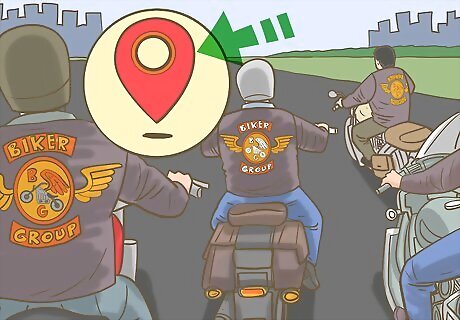
Establish a designated meeting place. At first, your meeting place will likely be your home, or perhaps your favorite bar or restaurant. As you continue to expand, however, you might consider buying or leasing a location to serve as an official clubhouse. There, you and your members can come together whenever you like to socialize, coordinate outings, and talk shop. Privately-owned buildings, standalone garages, basements, and renovated barns could all make good clubhouses. Make sure your meeting place is somewhere central to all of your members, if possible. It may not always be convenient for them to come to you if they’re traveling from an outlying area.
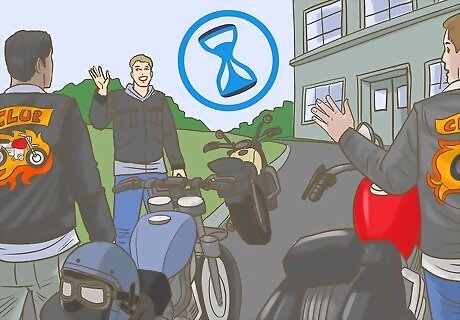
Schedule regular times to meet. At their core, all motorcycle clubs are social groups, which means getting together to ride and have a good time is what it’s all about. Try to make time on a weekly, bi-weekly, or monthly basis to assemble for group runs and other events. Encourage as many members as possible to be present for club meetings. You might even make regular attendance a requirement for continued membership. Of course, you don’t have to ride every time you meet. You could also use your time to discuss club-related affairs, plan events, or simply hang out. Communicate with your members to schedule meetings for times and dates that accommodate their lives outside of the club.
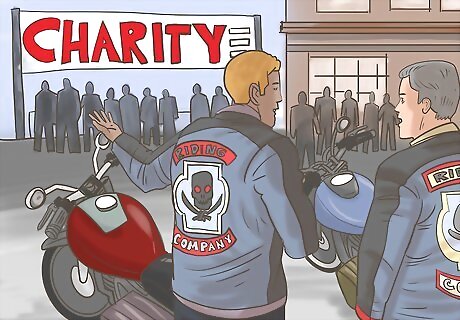
Plan fundraisers to give back to your community. Community-building is a crucial aspect of many motorcycle clubs. To this end, putting on charitable events like exhibition races, food and toy drives, and donation-based raffles can be a good way to raise money for various causes. This in turn will help you make a connection with the people in your hometown and improve your standing and public image. Reach out to local businesses who might be interested in sponsoring your event or providing services like catering or entertainment. If you strike up a solid working relationship, you could find yourself in a position to partner with them on bigger events in the future. Even if your events don’t generate a profit, they can still provide an opportunity to bring people together and strengthen community ties.Tip: Make sure you set up your events by the book. The last thing you want is to get shut down because your local law enforcement agencies think you're doing something illegal.


















Comments
0 comment